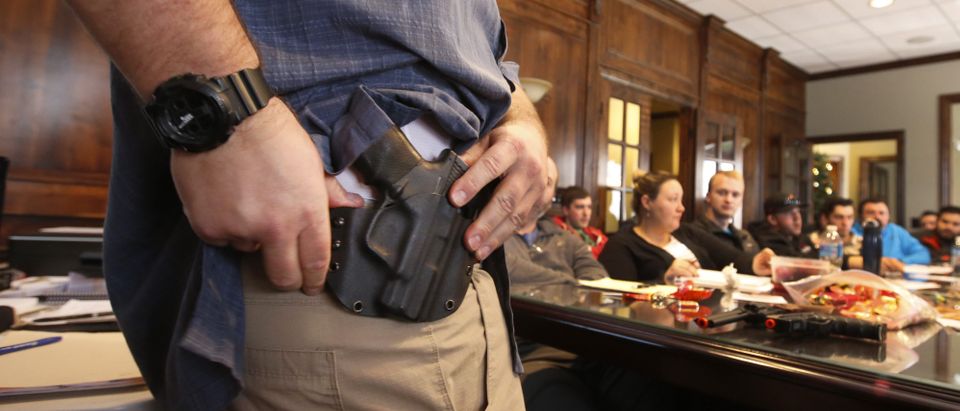By Sam Hoober, Alien Gear Holsters
A man’s home is his castle, and a great many states have either a de jure or de facto “Castle Doctrine” on the books allowing a person to defend themselves in their home if threatened, with deadly force if necessary. These laws, along with the “Stand Your Ground” laws, establish the right of a person to defend themselves if attacked.
Even California has such a law, even though that state is generally held to be loathe to let anyone have a permit to carry a gun in a concealed carry holster, or even openly for that matter. (Though some counties are far more permissive than others.)
It’s not even uniquely American; it’s not even that modern, even though a number of Castle Doctrine laws have been passed within the last few decades. The concept at law is a remnant of English common law (an Englishman’s home is his castle) and many other Western cultures have had similar conventions. Furthermore, similar laws are on the books in many other countries around the world.
However, the Castle Doctrine, such as it is, has limitations. The exact nature of each castle doctrine statute varies by state, so it behooves a person to know the applicable law in their state. An Alabaman should look up the Alabama castle doctrine, an Idahoan should verse themselves in the Idaho castle doctrine and so on and so forth.
In a more general sense, however, the basis of the law is that a person has no duty to retreat and can defend themselves in their own home (or – depending on the jurisdiction – any other location where they have a right to be) from someone who either attacks them in their home or forcibly enters. In other words, just as in other situations, there has to be a real, substantial threat or at least intentional forced entry.
As to forced entry, a person who kicks down a door means to break in. A person who walks into an open door on the other hand, even if they have no right to be there may be another matter because they didn’t technically force their way in. Mere trespassing alone is also not a justification to shoot a person, even under some form of castle doctrine law.
In fact, a forced entry or attempted one may not serve as justification alone – take the case of one David Petterson. Petterson, according to the Duluth News Tribune, awoke in early Jan. 2017 to three teenagers “casing” his home in Madelia, Minn. and attempting to break in. He confronted one of them on his deck, who jumped off the second-story deck, breaking his ankle and started to crawl toward a car parked nearby. Petterson retrieved his handgun and shot at the three men as they attempted to flee, hitting one – one Nicholas Embertson – who later died from the wound.
Petterson was arrested on Jan. 28, for negligent discharge of a firearm and is facing second-degree manslaughter charges. In this instance, while there was an attempted forced entry, the burglars were trying to flee. Petterson claimed he was trying to shoot the tire of their getaway car, but since they weren’t posing a threat the castle doctrine wouldn’t apply.
Another instance where the Castle Doctrine’s protections didn’t apply was the Byron David Smith case from 2012. Two burglars broke into his house in Nov. 2012, in Little Falls, Minn., whilst Smith was in the basement. One of them, Nicholas Brady, soon appeared at the top of the basement stairs. Smith shot him twice, and after Brady had tumbled to the bottom of the stairs, Smith shot him again, fatally. His accomplice, Haile Kifer, followed a few moments later, who Smith also shot at the top of the stairs. After she fell to the bottom, he shot her several times in the chest and finally under the chin, killing her.
Smith also didn’t call police until the next day, as it was Thanksgiving and he “didn’t want to bother them” during the holiday.
Smith was convicted of two counts of first-degree and second-degree murder each, and likely won’t leave prison alive. Minnesota has a Castle Doctrine law, and at the time Smith would have been cleared after the initial shots.
The two intruders forcibly broke in, that much is clear, but both were disabled after they were shot at the top of the stairs. The shots that followed weren’t defensive; the burglars were executed, which there is no legal justification for. Audio and video of the incident, recorded by Smith’s security system, all but cemented the punitive nature of the follow-up shots, as did his statements to police.
Plenty of other examples exist where the mere presence of an intruder was not justification enough to shoot them. While the Castle Doctrine is a nearly universal law amongst most cultures for obvious reasons, there are limits to it. Just as in any other situation, there has to be a clear and present danger. Otherwise, it becomes a criminal act.
Click here to get your 1911 Pistol Shopping Guide.
Click here to get The Complete Concealed Carry Training Guide
Sam Hoober is Contributing Editor for AlienGearHolsters.com, a subsidiary of Hayden, ID, based Tedder Industries, where he writes about gun accessories, gun safety, open and concealed carry tips. Click here to visit aliengearholsters.com.


